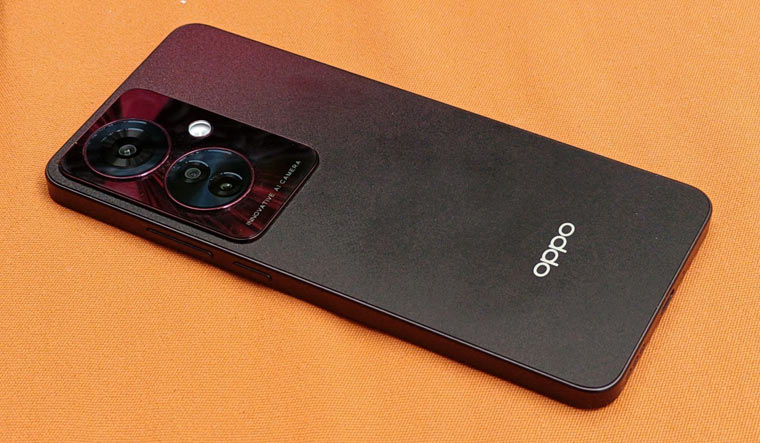Oppo has recently announced its new F25 Pro under its F series of smartphones, starting at Rs. 23,999 for the base model and Rs. 25,999 for the higher one. The company seems to be highlighting the device’s design cand camera capabilities more than anything else. Let’s try and see if the device brings anything worthy to this competitive price segment.
Available in Lava Red (the one I tried) and Ocea Blue colour options, the first thing I noticed about the device is its shimmery yet subtle dark red back with slightly glossy feel to it. You get curved corners and a 6.7-inch display with thin bezels (that are not perfectly symmetrical) with Panda glass on top for protection. The back carries triple camera system on the back placed an elevated rectangular cut-out, while the Oppo logo sits near the bottom. The right side locates the volume buttons and Power/lock key near the middle; while the left side only has the dual SIM card plus microSD card tray near the top corner. The top only has the secondary mic; the bottom carries the primary mic, USB type C port and loudspeakers. The front-facing camera and ear-speaker grille are tucked nicely next to each other without being an eye sore.
The F25 Pro weighs under 180 grams and measures about 7.54mm in thickness, making it one of the thinnest 5G smartphones out there. The rest of the body is made of polycarbonate with resin compound added, as per Oppo. The phone feels sturdy to hold and carry around and isn’t very slippery either.
Sporting a 6.7-inch full HD+ (2412x1080) OLED panel with up to 120Hz refresh rates, the phone doesn’t really compromise on sharpness. This is a pretty nice panel for the price tag with good viewing angles, clear to read text and view high resolution images or for watching high resolution videos, including over YouTube. It’s an HDR10+ certified display, so you can play compatible content over Netflix, giving decent but not too great HDR output, which is kind of common for this price range, but what’s otherwise a good display.
The triple camera system on the back is another point among highlights of this phone – 64MP (f/1.7) main camera, 8MP (f/2.2) ultra-wide camera, and a 2MP (f/2.4) macro camera. The phone can take detailed shots with decent dynamic range in good lighting conditions. Portrait mode is a bit of a hit and miss, when it delivers, it can really produce nice bokeh effect with edges and even hair for your subject, but a lot of times it would produce undercooked shots with the loss of colour for the subject. The front-facing 32MP (f/2.4) camera is a really good one, definitely one of the best among
Android phones under 25k when it comes to colour calibration and skin tones provided retouch has been disabled and without any added filters, in my opinion.
The phone is powered by MediaTek’s Dimensity 7050 chipset (up to 2.6Ghz octa core processor, Mali-G68 MC4 GPU) and runs on ColorOS 14 based on Android 14 with the February security patch installed. The phone handled basic tasks such messaging, switching between social media apps, scrolling between media heavy apps and so on without any stuttering noticeable. The phone didn’t heat up with games such as Genshin Impact at low settings, gameplay quite smoothly but of course not at its highest settings, while a game like Monument Valley were handled pretty smoothly. ColorOS comes with a lot of third party apps pre-loaded, some perhaps you may have never used or have any intentions to use, most of these can be uninstalled pretty quickly, but it takes a few minutes and steps back and forth to uninstall these and disable things such as Hot Games.
Otherwise, the ColorOS is a feature-rich Android skin that doesn’t have too many misses. Many of the supported third party apps ran in 90Hz, and the phone didn’t show any lags while using these. The one place the phone did heat up a bit was during extensive use of the camera when outdoors. Powered by a 5,000mAh battery unit, the phone lasted ma day quite frequently and didn’t show any unnecessary battery drains during my usage. The bundled 67watt SuperVooc charger charges the phone from 1% to full in about 50 minutes or so without any heating issues.
Call quality, 5G reception and GPS didn’t show any unusual drops during my usage. One thing that does feel a bit of a miss is the single bottom-facing speaker with no stereo pair to go with it, so the loudspeaker output is just okay for gaming and multimedia consumption.
Verdict: The sub 25k market seems to be really getting competitive again, with the likes of the Realme 12 Pro, Samsung Galaxy M34 and OnePlus Nord 3CE, and it seems the Oppo’s F25 Pro has a lot of things going around it to take on the competition. It has its flaws such as too many third party apps out of the box (which can be dealt with by the user), hit or miss low-light camera performance, and loudspeaker quality, but overall it performs really well on the battery, display and design departments.


